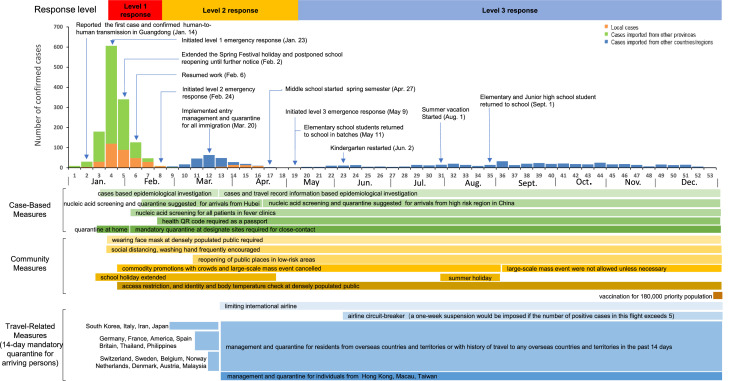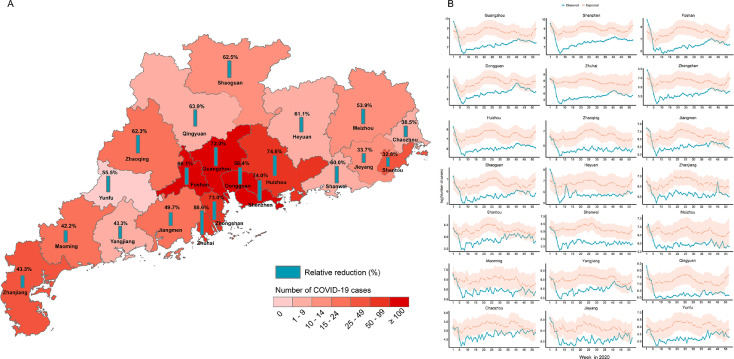Unexpected gains from prevention and control in COVID-19: Last year, 39 infectious diseases in Guangdong reduced the incidence by nearly one million people.
New research shows that in 2020, Guangdong successfully controlled the epidemic situation in COVID-19 with non-drug intervention measures (NPI), but also "unexpectedly" achieved the containment effect of other 39 legal infectious diseases, with the total number of cases falling by 65.6% than expected, reducing the incidence of nearly one million people.
On October 1, local time, The Lancet Regional Health-Western Pacific, a journal of the The Lancet, a top international medical journal, published the research result online: Co-benefits of non-drug intervention measures in COVID-19, China. nonpharmaceutical intervention against COVID-19 on infectious diseases in China: A large population-based observational study)。

Screenshot of the paper.
This study systematically evaluated the incidental benefits of non-drug intervention measures (NPI) in the prevention and control of other infectious diseases in COVID-19, Guangdong Province in 2020. The results showed that the total number of cases of 39 legal infectious diseases (excluding COVID-19) in Guangdong Province decreased by 65.6% compared with the expected number in 2020, which means that 982,000 cases of infectious diseases may have been avoided in Guangdong Province that year because of NPI measures in COVID-19. The research evidence provides an important basis for the intervention of many infectious diseases in the future.
The first authors of this study are Xiao Jianpeng and Hu Jian Xiong of Guangdong Institute of Public Health, Dai Jiya of Guangdong Center for Disease Control and Prevention, and Tamia Liu of School of Basic Medicine and Public Health of Jinan University. Correspondents are Zhong Haojie, Director of Public Health Emergency Department of Guangdong Center for Disease Control and Prevention, and Ma Wenjun, Professor of School of Basic Medicine and Public Health of Jinan University.
The number of infectious diseases among children decreased by 82.1%, with 784,000 fewer infections.
Non-drug intervention measures (NPI) have achieved remarkable results in the prevention and control of epidemic situation in COVID-19. Guangdong is one of the provinces with the highest risk of epidemic threat in China. At different stages of prevention and control, Guangdong has taken a series of targeted NPI measures, such as traffic restrictions, entry control, case isolation, nucleic acid screening, close contact tracking, keeping social distance, encouraging wearing masks and paying attention to personal hygiene.

The epidemic process of COVID-19 in 2020 and the public health intervention measures. Paper drawings
Due to strict non-drug intervention measures (NPI), Guangdong has successfully controlled the imported epidemic situation outside the province and curbed the local clustering epidemic caused by imported cases. At the same time, what unexpected gains did non-drug intervention (NPI) bring?
This study compared the incidence of 39 legal infectious diseases (excluding COVID-19) between 2020 and 2015-2019, and found that the incidence of these 39 infectious diseases decreased by 50.7% in 2020, much higher than the national decline of 25.5%. The researchers believe that this may be due to the stricter implementation of non-drug intervention measures (NPI) in Guangdong, which is due to the more cases of COVID-19 reported in Guangdong in the early stage and the continuous pressure of importing epidemic situation.
The researchers further used a mathematical model to simulate the expected number of 39 legal infectious diseases per week in Guangdong Province without the COVID-19 epidemic. The results show that the total number of 39 cases of infectious diseases in Guangdong Province decreased by 65.6% compared with the expected number in 2020, which means that 982,000 cases of infectious diseases may have been avoided in Guangdong Province in 2020 because of NPI measures in COVID-19.

Percentage reduction and changing trend of legal infectious diseases in 21 cities of Guangdong Province in 2020. Paper drawings
Among them, the decline rate of children’s cases is the highest, reaching 82.1% (it is expected to reduce 784,000 cases), which is much higher than that of adults (38.2%) and the elderly (26.2%). Researchers believe that there may be several reasons for the highest decline in children’s cases: First, children are the main epidemic groups of infectious diseases (such as hand, foot and mouth disease and influenza); Second, during the COVID-19 epidemic, schools or kindergartens delayed going to school or suspended classes, thus avoiding the gathering of people; Third, during the epidemic, students should strengthen hand hygiene, wear masks, and schools should strengthen campus management, which greatly reduces the risk of pathogen transmission.
Researchers believe that non-drug intervention measures are not only the key to prevent and control COVID-19, but also the important measures to prevent and control the epidemic of other infectious diseases, especially for children’s infectious diseases, respiratory infectious diseases (such as influenza) and intestinal infectious diseases (such as hand, foot and mouth disease). These evidences have important guiding significance for formulating public health intervention policies for infectious diseases in the future.
The epidemic of dengue fever was contained, and the number of cases decreased by 99.3%.
According to the paper, from the perspective of disease types, the five infectious diseases affected by non-drug intervention measures (NPI) have the largest decline in the number of cases: dengue fever (down 99.3%, estimated to reduce 7070 cases), influenza (down 95.1%, estimated to reduce 683566 cases), whooping cough (down 90.3%, estimated to reduce 6413 cases) and scarlet.
Dengue fever has always been a major infectious disease in Guangdong. In 2020, the number of cases of dengue fever in Guangdong decreased greatly, and only 58 cases were reported in the whole year. One of the important reasons was that there were few imported cases due to restrictions on inbound flights and customs quarantine.

The number of reported cases of dengue fever in Guangdong Province and the flight flow into Guangdong Province from 2015 to 2020. Guangdong Provincial Institute of Public Health
It is estimated that the number of flights entering Guangdong in 2020 decreased by 83.1% compared with the average in 2018-2019, and the number of inbound personnel decreased greatly. In 2020, there were 45 imported cases of dengue fever in Guangdong Province, while in 2015-2019, the annual average number of imported cases was 387. Most of the imported cases were managed in isolation places.
Generally speaking, dengue fever is a seasonal infectious disease in Guangdong, which is occasionally caused by imported cases of dengue fever. Since the number of imported cases will be greatly reduced in 2020, the risk of local transmission of dengue fever in Guangdong will also be reduced.
The researchers believe that this study provides new ideas for the prevention and control of dengue fever in China. In the future, moving forward the prevention and control gateway, strengthening customs quarantine and tracking the health of entry personnel can be used as important means to prevent and control dengue fever.